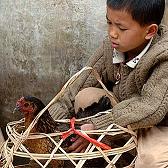China reports new AI outbreak, shares samples

China has reported a new outbreak of bird flu in the country’s north, and has also shared long-awaited samples of bird flu virus strains with the global scientific community.
A new outbreak of the H5N1 strain of bird flu killed 985 chickens in the country’s northern region of Inner Mongolia, according to local news reports.
The discovery of bird flu in a village near the city of Baotou prompted authorities to destroy almost 9,000other chickens to prevent the virus from spreading.Meanwhile, the World Health Organisation (WHO) says that China has shared long-sought samples of the H5N1 bird flu virus, in what many scientists view as a breakthrough in cooperation.
WHO officials said samples, taken from some of the thousands of wild birds which died in Qinghai Lake in April 2005, have been sent to the US Centers for Disease Control (CDC), a WHO collaborating centre in Atlanta, for further analysis.
WHO scientist Michael Perdue said the animal samples, the first from China in two and a half years, should help scientists understand the origin of a sub-type of the deadly H5N1 virus which later circulated in Turkey and Africa but is genetically different from the one hitting other parts of Asia, including Indonesia, Thailand and Vietnam.
WHO officials said samples, taken from some of the thousands of wild birds which died in Qinghai Lake in April 2005, have been sent to the US Centers for Disease Control (CDC), a WHO collaborating centre in Atlanta, for further analysis.
WHO scientist Michael Perdue said the animal samples, the first from China in two and a half years, should help scientists understand the origin of a sub-type of the deadly H5N1 virus which later circulated in Turkey and Africa but is genetically different from the one hitting other parts of Asia, including Indonesia, Thailand and Vietnam.
H5N1 has killed at least 148 people worldwide since it started ravaging poultry stocks in Asia three years ago, according to WHO figures.
China has reported dozens of H5N1 outbreaks in its vast poultry flocks and has destroyed millions of birds in an attempt to stop the spread of the virus.
China has suffered 13 human deaths from bird flu, including a soldier who died in 2003 but whose infection was only confirmed in August this year through genetic testing.
Eight earlier poultry outbreaks were recorded this year in central China and areas of the north, east and southwest.













